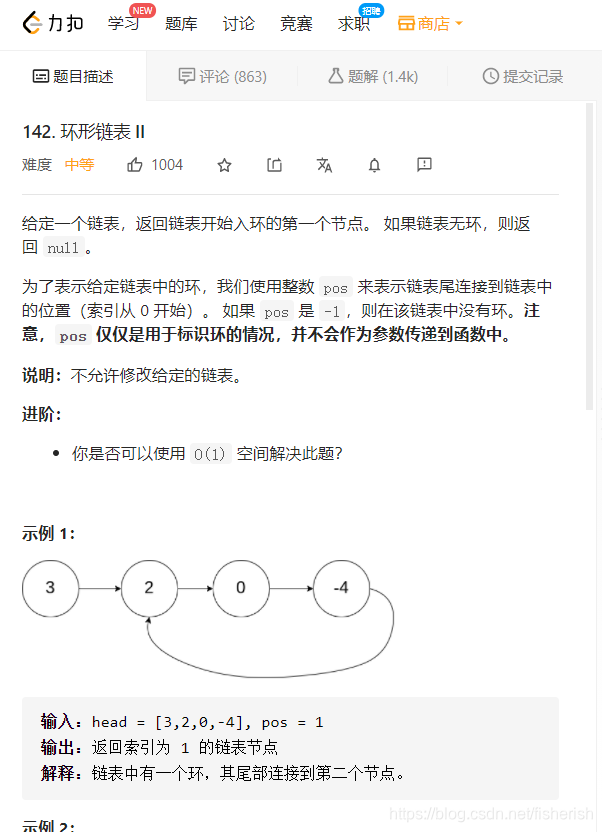题目描述

// 142. 环形链表 II
// 给定一个链表,返回链表开始入环的第一个节点。 如果链表无环,则返回 null。
// 为了表示给定链表中的环,我们使用整数 pos 来表示链表尾连接到链表中的位置(
// 索引从 0 开始)。 如果 pos 是 -1,则在该链表中没有环。注意,pos 仅仅是用于
// 标识环的情况,并不会作为参数传递到函数中。
// 说明:不允许修改给定的链表。
// 进阶:
// 你是否可以使用 O(1) 空间解决此题?
题解
/**
* Definition for singly-linked list.
* class ListNode {
* int val;
* ListNode next;
* ListNode(int x) {
* val = x;
* next = null;
* }
* }
*/
// HashSet法
// 如果借助hashset就太简单了。直接指针cur一边移动一边把结点存入set,
// 存不进去说明已经遇到重复结点,第一个遇到的重复结点就是环的入口。
// 返回当前遍历节点即可。如果cur遇到null,直接返回null
// 执行用时:4 ms, 在所有 Java 提交中击败了21.00%的用户
// 内存消耗:39.7 MB, 在所有 Java 提交中击败了5.09%的用户
import java.util.HashSet;
public class Solution {
public ListNode detectCycle(ListNode head) {
if (head == null || head.next == null)
return null;
HashSet<ListNode> set = new HashSet<>();
ListNode cur = head;
while (cur != null) {
if (!set.add(cur))
return cur;
cur = cur.next;
}
return null;
}
}
// 双指针法
// 定义intersection函数:
// 先快慢针判断是否有环,有环,快针慢针第一次相遇地点被记录,无环,返回null。
// 这个地方跟 141. 环形链表 很像,又有不同,不能用不同起点的快慢针法,必须要
// 同起点的快慢针法。
//
// 快针慢针第一次相遇地点记录为inLoop,之后从头再构造一个指针outLoop,
// inLoop从第一次相遇地点开始走,outLoop从头开始走,两指针相遇的地点
// 一定是环形链表的环入口。返回该相遇点即可。
//
// 执行用时:1 ms, 在所有 Java 提交中击败了32.80%的用户
// 内存消耗:38.6 MB, 在所有 Java 提交中击败了51.78%的用户
public class Solution {
public ListNode detectCycle(ListNode head) {
ListNode inLoop = intersection(head);
if (inLoop == null)
return null;
ListNode outLoop = head;
while (inLoop != outLoop) {
inLoop = inLoop.next;
outLoop = outLoop.next;
}
return inLoop;
}
public ListNode intersection(ListNode head) {
if (head == null || head.next == null)
return null;
ListNode pre = head;
ListNode cur = head;
while (cur != null && cur.next != null) {
cur = cur.next.next;
pre = pre.next;
if (cur == pre)
return cur;
}
return null;
}
}


























 280
280

 被折叠的 条评论
为什么被折叠?
被折叠的 条评论
为什么被折叠?










